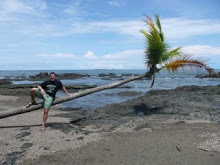




Well, we ended up not going to Montecristo, but instead we went to a family owned coffee plantation named Del Cafe Tal. It was wonderful experience to see how coffee is produced and prepared. In the first picture, you can see a beautiful shot taken just before we got to the plantation. The next picture shows all of the coffee plants lined up in rows. It was very interesting to see that the coffee bean is actually inside of a red pulp, and that all of the workers must first remove the bean from the plant and then the red pulp. The next picture is of a machine that they use to help prepare the beans, and then they must lay them out to dry out on the tables shown in the fourth picture. The final picture is of me standing in the coffee field after I had picked my own coffee bean. After our trip to the Del Cafe Tal plantation, which was high in the mountains (to allow the beans to aquire a more acidic flavor), we rode on the bus back to the town. There the family owned business has their own coffee shop for the locals. After going inside, the owner showed us a roaster that they use for preperation of the bean. El cafe fue excellente!!!
The entire process of how coffee is prepared is very interesting. The actual coffee bean that is picked is inside of a berry. The berry most be washed off in order to receive the bean. For a period of time the pulp was deposited into rivers, but in order to become more sustainable the Costa Rican government put a stop to it through environmental laws. Now, the pulp is returned back to the fields and used as a fertilizer. This is an excellent example of waste = food from Cradle to Cradle. Then there is another layer of skin on the bean that must be rubbed off and then the bean is ready. Next, the beans must be roasted using machines. However, the traditional way was to let them dry out in the sun.
I also wanted to add some Costa Rican coffee recipes that I fould interesting:
Caribbean (hot) 8 servings
1 coconut 2 cups milk 4 cups strong coffee 1 tablespoon sugar
Punch two holes in to coconut, pour liquid into saucepan
Bake coconut for 30 minutes at 300 F degrees
Break open coconut, remove meat, and grate.
Mix coconut meat, coconut liquid, and milk in a sauce pan
Heat over low heat until creamy.
Strain
Toast grated coconut under broiler
Mix milk mixture, coffee, and sugar
Pour into mugs, garnish with toasted coconut.
1 coconut 2 cups milk 4 cups strong coffee 1 tablespoon sugar
Punch two holes in to coconut, pour liquid into saucepan
Bake coconut for 30 minutes at 300 F degrees
Break open coconut, remove meat, and grate.
Mix coconut meat, coconut liquid, and milk in a sauce pan
Heat over low heat until creamy.
Strain
Toast grated coconut under broiler
Mix milk mixture, coffee, and sugar
Pour into mugs, garnish with toasted coconut.
Grog (hot) 6 servings
3 cups coffee 1/2 cup heavy cream 1 cup brown sugar 2 tablespoons softened butter 1/4 teaspoon ground cloves 1/4 teaspoon ground nutmeg 1/4 teaspoon cinnamon Peel of one large orange, broken into 6 pieces Peel of one large lemon, broken into 6 pieces
Place one piece of each peel into cups
Mix butter, sugar, cloves, nutmeg and cinnamon
Mix coffee and cream
Pour both mixtures into cups and stir.
3 cups coffee 1/2 cup heavy cream 1 cup brown sugar 2 tablespoons softened butter 1/4 teaspoon ground cloves 1/4 teaspoon ground nutmeg 1/4 teaspoon cinnamon Peel of one large orange, broken into 6 pieces Peel of one large lemon, broken into 6 pieces
Place one piece of each peel into cups
Mix butter, sugar, cloves, nutmeg and cinnamon
Mix coffee and cream
Pour both mixtures into cups and stir.
Overall, it was a great experience to come to Costa Rica and see not only how coffee is produced and other sustainable issues along with it, but also to taste the wonderful coffee!

No comments:
Post a Comment